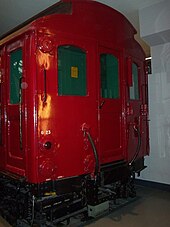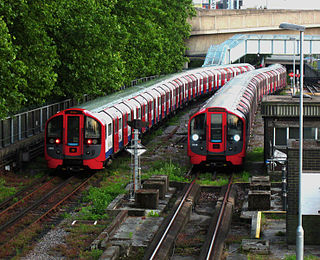
London Underground rolling stock includes the electric multiple-unit trains used on the London Underground. These come in two sizes, smaller deep-level tube trains and larger sub-surface trains of a similar size to those on British main lines, both running on standard gauge tracks. New trains are designed for the maximum number of standing passengers and for speed of access to the cars.

The Standard Stock title was applied to a variety of Tube stock built between 1923 and 1934, all of which shared the same basic characteristics, but with some detailed differences. This design is sometimes referred to as 1923 Tube Stock, 1923 Stock, or Pre 1938 Stock. Most of the Standard Stock was built to replace the first generation of "Gate Stock" Tube trains or to provide additional trains for extensions built in the 1920s and early 1930s. Standard Stock cars consisted of motor cars, with a driver's cab, behind which was a "switch compartment" occupying approximately one-third of the length of the car, plus trailer cars and "control trailers", with a driving cab but no motor. All were equipped with air operated sliding doors. The guard's door on the earlier trains was a manually operated, inward-opening hinged door.
The Lancashire and Yorkshire Railway (LYR) built suburban electric stock for lines in Liverpool and Manchester. The line between Liverpool to Southport began using electric multiple units (EMUs) on 22 March 1904, using a third rail 625 V DC. Additional trains were later built for this route, and in 1913 incompatible stock for the route to Ormskirk. Lightweight units were built to run on the Liverpool Overhead Railway.
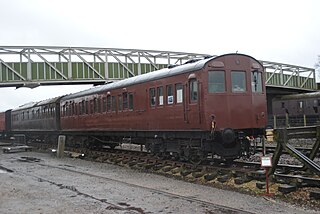
The T Stock was a series of electric trains originally built in various batches by Metropolitan-Vickers and the Birmingham Railway Carriage and Wagon Company for the Metropolitan Railway in 1927–31 for use on electric services from Baker Street and the City to Watford and Rickmansworth, though rarely some worked on the Uxbridge branch.

The London Underground R Stock electric multiple units were used on London Underground's District line from 1949 to 1983. Composed of new cars and converted Q38 Stock trailers, the cars were built and converted in three batches between 1949 and 1959. The cars were driving motors (DM) or non-driving motors (NDM), there being no unpowered trailers. The second batch, introduced in 1952, was constructed from aluminium, saving weight and one train was left unpainted as an experiment. Considered a success, trains were left unpainted or painted white or grey to match in 1963–68. Originally designed to operate in trains with six off-peak and eight cars during peak hours, the trains were reformed as fixed seven-car trains in 1971. R Stock trains were replaced by the D78 Stock and withdrawn between 1981 and 1983.

The G Stock were 50 electric multiple unit train carriages built for the District Railway in 1923 by Gloucester RC&W. They operated on the District line of the London Underground until 1971.

The Q Stock consisted of various District line trains built from 1923 until the mid-1930s, originally built with manually operated sliding doors. Following conversion to air operated doors, the trains became collectively known as Q Stock. Given that five different types of rolling stock were converted to Q Stock, the resulting hybrid trains looked bizarre - with the older carriages having flat sides and clerestory roofs, whilst the Q38 had flared sides at floor level.

The London Underground O and P Stock electric multiple units were used on the London Underground from 1937 to 1981. O Stock trains were built for the Hammersmith & City line, using metadyne control equipment with regenerative braking, but the trains were made up entirely of motor cars and this caused technical problems with the traction supply so trailer cars were added. P Stock cars were built to run together with the O Stock cars now surplus on Metropolitan line Uxbridge services. The trains had air-operated sliding doors under control of the guard; the O Stock with controls in the cab whereas the P Stock controls in the trailing end of the motor cars. The P Stock was introduced with first class accommodation, but this was withdrawn in 1940.

The London Underground 1960 Stock was a class of electric multiple unit for the London Underground Central line. Twelve motor cars were supplied by Cravens, and pairs were made up to four cars by the addition of two converted standard stock trailers. A production run of 338 motor cars was shelved, due to the time needed to assess the new features and the cost of converting the trailer cars. Some of the pre-1938 trailers were later replaced by 1938 stock trailers.

London Underground battery-electric locomotives are battery locomotives used for hauling engineers' trains on the London Underground network where they can operate when the electric traction current is switched off. The first two locomotives were built in 1905 for the construction of the Great Northern, Piccadilly and Brompton Railway, and their success prompted the District Railway to buy two more in 1909, which were the only ones built to the loading gauge of the subsurface lines. Following this, a number of battery vehicles were built by converting redundant motor cars, with the batteries placed in the unused passenger compartment. One exception to this was made by the City and South London Railway, who used a trailer car to hold the batteries, and wired them to a separate locomotive.

An electric multiple unit (EMU) is an electric self-powered train, capable of operating in multiple with other EMUs and without the need for a locomotive; these are typically passenger trains with accommodation in every vehicle and a driving position at each end. The term can also be used to describe a train that is a permanent formation with a non-driving power car, such as the Advanced Passenger Train. As of December 2010, two-thirds of the passenger carriages in Great Britain are formed in EMUs.
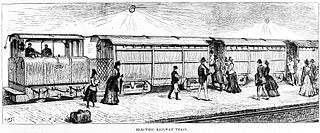
Electric locomotives were first used on the London Underground when the first deep-level tube line, the City and South London Railway (C&SLR), was opened in 1890. The first underground railways in London, the Metropolitan Railway (MR) and the District Railway (DR), used specially built steam locomotives to haul their trains through shallow tunnels which had many ventilation openings to allow steam and smoke to clear from the tunnels. It was impractical to use steam locomotives in the small unvented tubular tunnels of the deep-level lines, and the only options were rope haulage or electric locomotives.
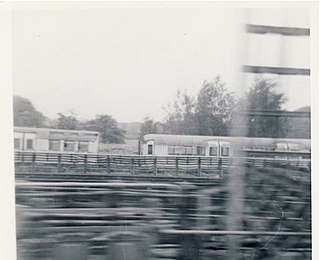
The London Underground 1935 Stock was an experimental train design by Metropolitan Cammell in London. Twelve two-car units, marshalled into four six-car trains, were built. They served as the prototypes for the later 1938 Stock.
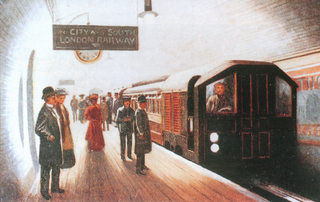
The Central London Railway Stock were electric multiple units composed of trailers that had been converted from carriages designed to be hauled by electric locomotives with new motor cars. The Central London Railway opened in 1900 with electric locomotives hauling wooden carriages, but the heavy locomotives caused vibrations that could be felt in the buildings above the route. It was found that conversion to electric multiple units solved the problem, so new motor cars were bought and replaced all the locomotives by June 1903. Trains normally ran with six-cars, four trailers and two motor-cars. Some trailers were equipped with control equipment to allow trains to be formed with three cars.

The London Underground Q Stock were trains used on the District line of the London Underground. First introduced in 1938, these electric multiple units were formed from cars built between 1923 and 1935 and new purpose-built cars, and fitted with electro-pneumatic brakes and guard controlled air-operated doors. Trains were made up from cars of different ages with differing appearances, the older ones with clerestory roofs and the newer ones with flared sides. Some units were withdrawn in the early 1960s, although six- and eight-car trains remained on the District line with use gradually diminishing to peak hours only, and four car units worked the East London line until 1971.

Metropolitan Railway electric multiple units were used on London's Metropolitan Railway after the lines were electrified in the early 20th century.

The history of the District line started in 1864 when the Metropolitan District Railway was created to create an underground 'inner circle' connecting London's railway termini. The first part of the line opened using Metropolitan Railway gas-lit wooden carriages hauled by steam locomotives. The District introduced its own trains in 1871 and was soon extended westwards through Earl's Court to Fulham, Richmond, Ealing and Hounslow. After completing the 'inner circle' and reaching Whitechapel in 1884, it was extended to Upminster in East London in 1902. To finance electrification at the beginning of the 20th century, American financier Charles Yerkes took it over and made it part of his Underground Electric Railways Company of London (UERL) group. Electric propulsion was introduced in 1905, and by the end of the year electric multiple units operated all of the services.

Departmental locomotives on the London Underground consist of vehicles of a number of types which are used for engineering purposes. These include battery locomotives, diesel locomotives, electric locomotives, sleet locomotives, pilot motor cars and ballast motor cars. Details of the first four types are covered elsewhere. Pilot motor cars and ballast motor cars are generally vehicles which have been withdrawn from passenger service, but continue to be used by the engineering department. Pilot motor cars are used to move other vehicles around the system, while ballast motor cars are used to haul ballast trains and engineering trains.

The London Underground opened in 1863 with gas-lit wooden carriages hauled by steam locomotives. The Metropolitan and District railways both used carriages exclusively until they electrified in the early 20th century. The District railway replaced all its carriages for electric multiple units, whereas the Metropolitan still used carriages on the outer suburban routes where an electric locomotive at the Baker Street end was exchanged for a steam locomotive en route.

Acton Works is a London Underground maintenance facility in West London, England. It is accessed from the District line and Piccadilly line tracks to the east of Acton Town station, and was opened in 1922. It was responsible for the overhaul of rolling stock, and gradually took on this role for more lines, until the formation of the London Passenger Transport Board in 1933, when all major overhauls of underground vehicles were carried out at the works. By 1985, when rolling stock had become more reliable and maintenance intervals had increased, this function was devolved to depots on each line. Subsequently, Acton continued to overhaul major items after they had been removed from trains at the depots, and tendered for work, which included the conversion of the A60 Stock to One Person Operation. It is likely to be reorganised and expanded to house the departments displaced from Lillie Bridge Depot which is being demolished as part of the redevelopment of Earls Court Exhibition Centre.


